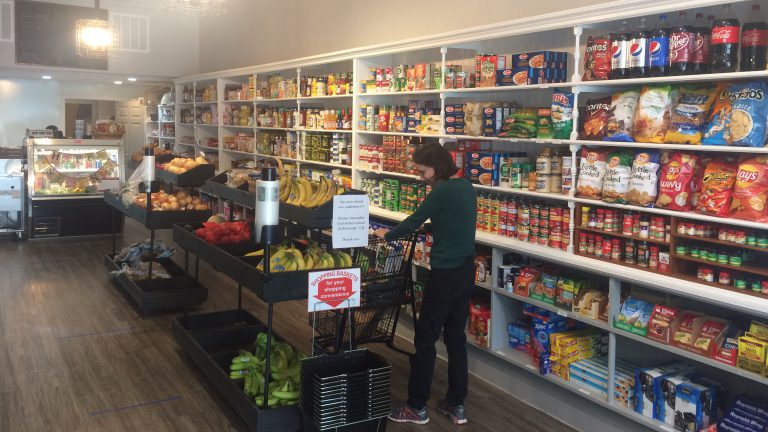John Paul Coonrod usually recognizes most of his customers. Lately, though, he says there have been a lot of unfamiliar faces at Great Scott! Community Market.
The small grocery store opened in Winchester, Ill. last year in what was once an old shoe store. It stocks your standard dried goods, canned goods and craft beer and wine, and has a deli section in back.
And since the start of the pandemic, the store has seen more business than ever.
“We’ve settled into a pretty good stasis of sales that are about double, I would say, what they were pre-COVID,” says Coonrod.
Coonrod says he thinks the boom in business is coming from both locals and out-of-towners, and there could be a number of reasons for the increase.
For one, due to lockdown orders, people who live in rural areas like Winchester aren’t travelling as much into urban areas for work, and are likely choosing to shop closer to home.

Due to his commute into work, Robin Lyons would usually shop at the Kroger 20 miles away, but now frequents Great Scott! Community Market.
“This is the time because these are our neighbors and our fellow townspeople,” Lyons says. “We’ve got to shop local.”
The appeal of smaller grocery stores might also be driving city-dwellers into more rural areas, according to Shannon McCord, owner of Ideal Market in Superior, Neb.
“Walmarts are always packed with people,” he says, adding that that makes it hard for customers to socially distance. “I think they decided to stay local… what it ended up doing is causing my store to be packed with people.”
McCord says he’s seen a 20-30% increase in sales since the start of the pandemic. Business is so busy, in fact, that he’s completely burned out from working 70-80 hour weeks for 10 weeks straight.
“It’s been tremendously difficult,” says McCord.
He says he’s been busy keeping up with inventory, as supply chain disruptions have made it hard to keep items like meat, flour and toilet paper in stock.
However, in many cases, smaller grocery stores have found workarounds by turning to their local communities.
After meatpacking plant closures, for example, McCord started working to pair area hog farmers with local butchers in hopes of keeping his meat case stocked.
And at Great Scott! Community Market in Illinois, it was flour that was in short supply.
“We’re a small grocery store and we’re absolutely at the bottom of the supply chain,” says Coonrod. “We’ll be the last ones to get something if it’s scarce.”
So, Coonrod decided to buy and repackage flour from local restaurants so he could sell it off his own shelves.
It’s a good example of how smaller, more rural grocery stores can adapt in difficult situations, says Rial Carver with Kansas State University’s Rural Grocery Initiative.
According to Carver, more than 20% of rural grocery stores in Kansas closed between 2008-2018. When one closes, she says it can have a lasting impact on the community.
“Often the folks that are hit the hardest are the older adults in the community and the lower income individuals in the communities who may not have the means or the capacity to get to a further away grocery store.”
The impact independent grocery stores have on their local communities can’t be overstated, says Carver. And as stay-at-home orders begin to loosen, store owners hope their new customers will continue to shop local.
Follow Dana on Twitter: @DanaHCronin
9(MDM5MjE5NTg1MDE1Mjk1MTM5NjlkMzI1ZQ000))

